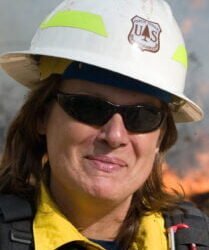Corrections chief hopes to county jail prisoners can fill dwindling pool of state prison applicants

In this Sept. 12, 2015, file photo, a California Department of Corrections and Rehabilitation inmate work crew builds a containment line ahead of flames from the Butte Fire, near Sheep Ranch, Calif. Scott Kernan, the newly appointed corrections secretary, said he is dropping, at least for now, a proposal to ease standards that would have allowed inmates with seven years left to serve on their sentences, an increase from the current five year limit.(AP Photo/Rich Pedroncelli, File)
DON THOMPSON, Associated Press
SACRAMENTO, Calif. (AP) — California’s new corrections chief is backing off a plan to lower standards for inmate firefighters, focusing instead on persuading county sheriffs to send more jail prisoners to the state program.
Scott Kernan, who took over last month as secretary of the Department of Corrections and Rehabilitation, said in an interview with The Associated Press that he expects California will have enough inmate firefighters for this year’s fire season despite a dwindling pool of candidates from state prisons.
The state is using more inmates with violent or serious criminal histories because recent laws have sent less serious offenders to county jails instead of state prisons, he said. Kernan hopes to use more of those local prisoners to fill the gap.
He’s dropping, at least for now, a proposal by former secretary Jeffrey Beard that would have let inmates participate if they have up to seven years to serve on their sentences, an increase from the current five-year limit. Kernan said an analysis showed that changing the limit wouldn’t have produced a significant increase in the number of qualified inmates.
Officials previously said they expected to ease the standard ahead of this year’s fire season, but controversy erupted in October after Beard sought to expand the number of inmates who could qualify despite having violent histories. Officials first denied, then acknowledged that they have long used inmates with violent pasts in the nation’s largest and oldest inmate firefighter program. Beard quickly withdrew his proposal.
Kernan defended the use of those inmates as vital to a program that last year provided nearly 1 of 5 state, federal and local firefighters battling major blazes.
About 40 percent of the roughly 3,700 inmate firefighters committed violent crimes including 59 manslaughters, more than 500 assaults or batteries, and more than 1,000 robberies, the department said in November.
Lowering standards could have added inmates with more incentive to misbehave or escape, Stanford Criminal Justice Center co-director Robert Weisberg said. But Kernan noted that inmates are reviewed to see if they are dangerous before they are sent to live in the unfenced fire camps or dispatched to fight fires without supervision from correctional officers.
“If you don’t change the rules of the prison, (the alternative) is to get them from county jails because that’s where a lot of inmates have shifted now,” Weisberg said.
Expanding inmates’ eligibility would have been a calculated risk, said University of California, Berkeley, law professor Frank Zimring, who has studied California prisons for more than 30 years. He warned that recruiting in jails may be tougher because many prisoners there have shorter sentences and may have active drug or mental health problems.
Weisberg and Zimring said they believe the program is worth the public safety risk.
Inmates must be physically fit and complete firefighting classes. Arsonists, kidnappers, sex offenders, gang affiliates and those serving life sentences for murder and other crimes are excluded.
Kernan said the state will have enough firefighters this year without changing its standards partly because the department has agreements with 12 county sheriffs, with four more in progress. They supply about 6 percent of the firefighters in the program, or 242 firefighters.
Counties pay the state for taking jail prisoners, generally $81 a day during training, then $10 a day after they are certified. Los Angeles County trains its own inmates.
Sheriffs initially said they couldn’t afford the program when the department proposed charging counties a higher rate after jail prisoners were trained.
California State Sheriffs’ Association spokesman Cory Salzillo said more sheriffs seem to be interested after the state dropped its daily rate two years ago. State finance officials said that is enough to cover county inmates’ food, clothing and pay so the state doesn’t lose money.
“I know that the sheriffs have challenges with their budget as well, but I think as we expand to the county level, I think it’s going to be able to keep our fire camp population at a right, reasonable level,” Kernan said.
Copyright 2016 The Associated Press. All rights reserved. This material may not be published, broadcast, rewritten or redistributed.




